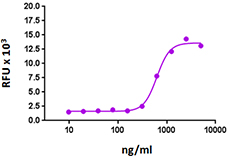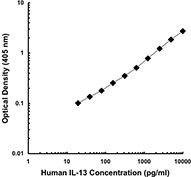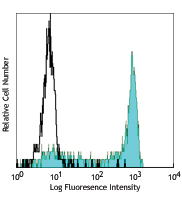- Clone
- A17158D (See other available formats)
- Regulatory Status
- RUO
- Other Names
- RAGE, AGER, Advanced glycosylation end product-specific receptor
- Isotype
- Mouse IgG2b, κ
- Ave. Rating
- Submit a Review
- Product Citations
- publications

-

Western blot of purified anti-RAGE antibody (clone A17158D). Lane 1: Molecular weight marker; Lane 2: 20 µg of human lung lysate. The blot was incubated with 0.5 µg/mL of the primary antibody overnight at 4°C, followed by incubation with HRP-labeled goat anti-mouse IgG (Cat. No. 405306). Enhanced chemiluminescence was used as the detection system. -

IHC staining of purified anti-RAGE antibody (clone A17158D) on formalin-fixed paraffin-embedded human lung tissue. Following antigen retrieval using Sodium Citrate H.I.E.R. (Cat. No. 928502), the tissue was incubated with 5 µg/ml of the primary antibody overnight at 4°C. Biolegend's Ultra Streptavidin (USA) HRP Detection Kit (Multi-species, DAB, Cat. No. 929901) was used for detection followed by hematoxylin counterstaining, according to the protocol provided. The image was captured with a 40X objective. Scale bar: 50 µm
| Cat # | Size | Price | Quantity Check Availability | Save | ||
|---|---|---|---|---|---|---|
| 855901 | 25 µg | 85€ | ||||
| 855902 | 100 µg | 221€ | ||||
RAGE (receptor for advanced glycation end products), is a member of the immunoglobulin super family of proteins with a molecular weight estimated at ~35 kD. RAGE is a pattern recognition receptor as it recognizes a common structure of a class of ligands, including HMGB1, S10012, S100B, S100A7, and amyloid precursor protein (APP). RAGE may play a role in the pathogenesis of neurodegenerative disorders such as Alzheimer’s disease (AD). Increased RAGE expression levels have been observed in neurons and microglia surrounding senile plaques. In addition, RAGE can mediate the transport of amyloid beta across the blood-brain barrier and its accumulation in the brain.
Product DetailsProduct Details
- Verified Reactivity
- Human
- Antibody Type
- Monoclonal
- Host Species
- Mouse
- Immunogen
- Recombinant Human RAGE
- Formulation
- Phosphate-buffered solution, pH 7.2, containing 0.09% sodium azide.
- Preparation
- The antibody was purified by affinity chromatography.
- Concentration
- 0.5 mg/ml
- Storage & Handling
- The antibody solution should be stored undiluted between 2°C and 8°C.
- Application
-
WB - Quality tested
IHC-P - Verified - Recommended Usage
-
Each lot of this antibody is quality control tested by Western blotting. For Western blotting, the suggested use of this reagent is 0.5 - 2.0 µg per ml. For immunohistochemistry, a concentration range of 5.0 - 10 µg/ml is suggested. It is recommended that the reagent be titrated for optimal performance for each application.
- RRID
-
AB_2783446 (BioLegend Cat. No. 855901)
AB_2783447 (BioLegend Cat. No. 855902)
Antigen Details
- Structure
- RAGE is a 404 amino acid protein with an apparent molecular mass of ~43 kD.
- Distribution
-
Tissue Distribution: Lung (major) and colon (less expressed)
Cellular Distribution: Plasma membrane, extracellular, and nucleus
- Function
- Functions as a pattern recognition receptor in the innate immune system that initiates proinflammatory responses.
- Interaction
- RAGE forms homo-dimers, and interacts with HMGB1, S100A1, APP, S100B, S100A12, and S100A14.
- Ligand/Receptor
- AGEs (advanced glycation end-products)
- Biology Area
- Cell Biology, Immunology, Innate Immunity, Neuroinflammation, Neuroscience
- Antigen References
-
- Barbezier N, et al. 2014. Ann. Biol. Clin. (Paris) 72:669.
- Kalea AZ, et al. 2009. Clin. Sci. (Lond) 116:621.
- Gene ID
- 177 View all products for this Gene ID
- UniProt
- View information about RAGE on UniProt.org
Related Pages & Pathways
Pages
Related FAQs
Other Formats
View All RAGE Reagents Request Custom Conjugation| Description | Clone | Applications |
|---|---|---|
| Purified anti-RAGE | A17158D | WB,IHC-P |
Customers Also Purchased
Compare Data Across All Formats
This data display is provided for general comparisons between formats.
Your actual data may vary due to variations in samples, target cells, instruments and their settings, staining conditions, and other factors.
If you need assistance with selecting the best format contact our expert technical support team.
 Login / Register
Login / Register 













Follow Us